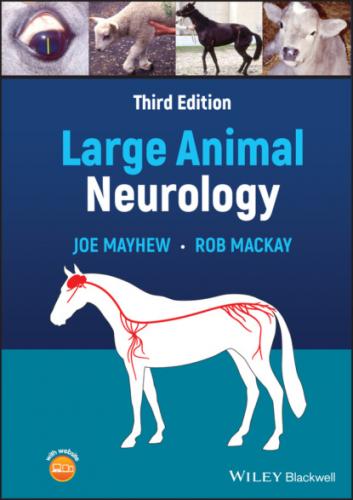9 Index
List of Tables
1 Chapter 2Table 2.1 The following tests and criteria can be evaluated in a physical e...Table 2.2 Outline of basic format for the neurologic examination, based on ...Table 2.3 Assessment of cranial nerve functionTable 2.4 Prominent gait and postural abnormalities present with neurologic...Table 2.5 Common clinical features with lesions involving central motor pat...Table 2.6 Examples of syndromes in which an organic neurologic lesion may b...
2 Chapter 31Table 31.1 Congenital, familial, and genetic disorders in calves with commo...Table 31.2 Diagnostic characteristics of the common diseases resulting in c...Table 31.3 Details of major lysosomal storage diseases of large animalsTable 31.4 A guide to differentiating five familial diseases resulting in p...
3 Chapter 32Table 32.1 Commonly reported neurologic signs in large animal rabies cases ...Table 32.2 Syndromes associated with various causes of viral encephalomyeli...Table 32.3 Overview of reported congenital malformations caused by in utero...Table 32.4 Comparison of various tests used to assist in the diagnosis of E...Table 32.5 TREATEPM‐1. A selection of drugs and their combinations used for...Table 32.6 TREATEPM‐2: Drugs and combinations approved for treatment of EPM ...
4 Chapter 33Table 33.1 Pathologic and clinical classification of traumatic brain injury...Table 33.2 Key steps in an ideal but quite logical scheme for immediate con...
5 Chapter 34Table 34.1 Examples of several poisonous plants that cause degrees of parapa...Table 34.2 Several acquired tremor syndromes affecting domestic herbivores a...
6 Chapter 35Table 35.1 Proportion of major clinical signs recorded for 104 cases of EMN...
7 Chapter 38Table 38.1 Reference table for acceptable minimal intravertebral and interv...
List of Illustrations
1 Chapter 1Figure 1.1 Basic areas of the brain can be readily recognized on this diagra...Figure 1.2 Basic monosynaptic spinal reflex pathway (patellar reflex) showin...Figure 1.3 Central motor neuronal pathways predominantly originate in the br...Figure 1.4 Sensory pathways convey somatic, proprioceptive, and visceral inp...Figure 1.5 Important cerebellar connections include subconscious general pro...Figure 1.6 Some cranial nerves are involved with specialized modalities such...Figure 1.7 A state of alertness or consciousness is maintained by the forebr...Figure 1.8 Functional regions of the forebrain include the frontal cortex A ...
2 Chapter 2Figure 2.1 Example of a neurological examination form of large (and small) a...Figure 2.2 A positive menace response is the observation that the patient bl...Figure 2.3 Many normal adult horses have slightly to moderately asymmetric t...Figure 2.4 Performing postural reactions such as hopping on one thoracic lim...Figure 2.5 Large regions of the forebrain of large domestic animals can be r...Figure 2.6 Visual pathway.Figure 2.7 Pupillary light pathway.Figure 2.8 Ocular sympathetic pathway.Figure 2.9 Visual and light pathways.Figure 2.10 Sympathetic pathways showing outflow from CNS to face, neck, and...Figure 2.11 Vestibular system.Figure 2.12 Pathway for the thoracolaryngeal response test.Figure 2.13 Heavy patients with various neuromusculoskeletal disorders can h...Figure 2.14 Stopping a patient abruptly after maneuvering it may result in a...Figure 2.15 Autonomous zones are areas of desensitivity that can be detected...Figure 2.16 This Holstein calf (A) suffered from vertebral trauma during an ...Figure 2.17 Very occasionally, portions of muscles, whole muscles, or muscle...Figure 2.18 Proximal limb atrophy more often is due to disuse mostly because...Figure 2.19 This foal developed sciatic paralysis after being treated for Kl...Figure 2.20 Complete paraplegia with good function in the thoracic
